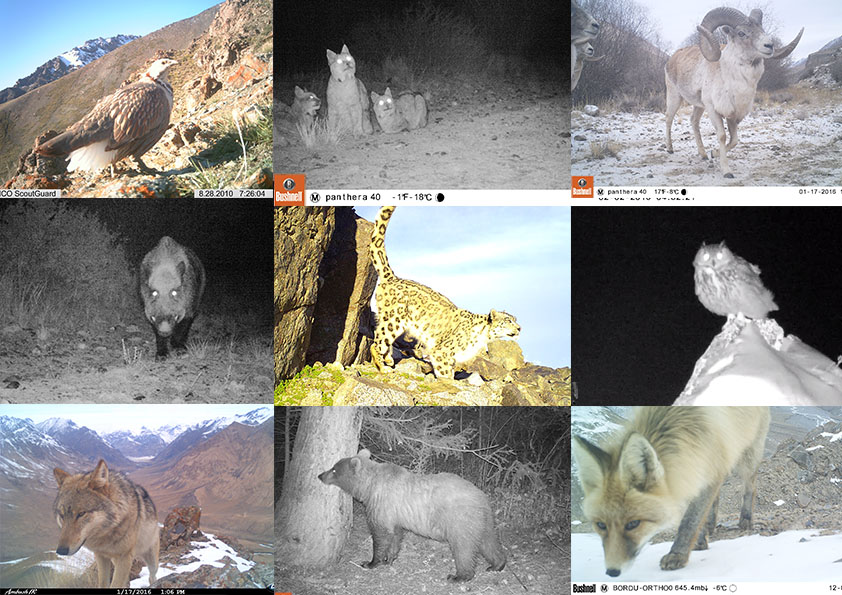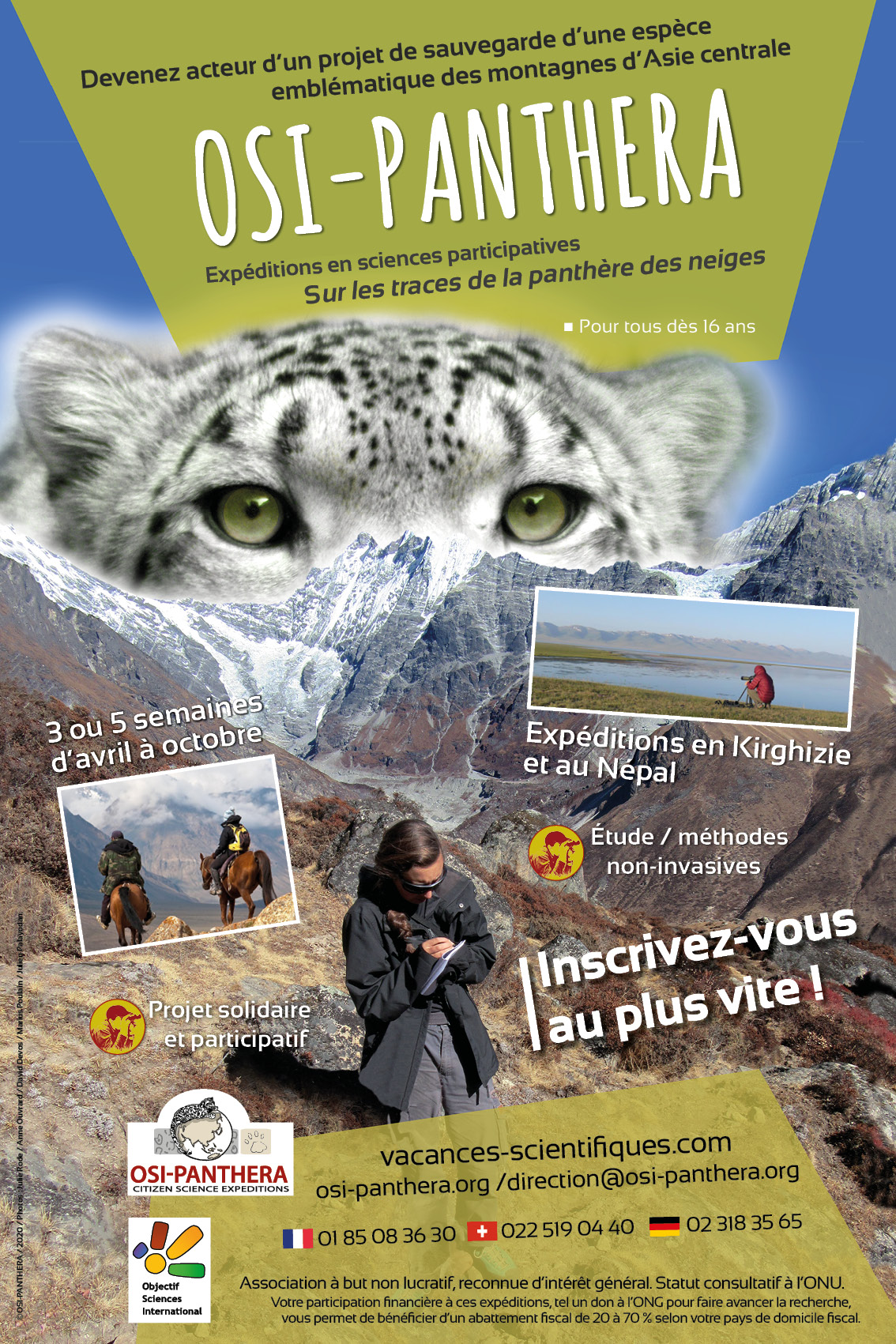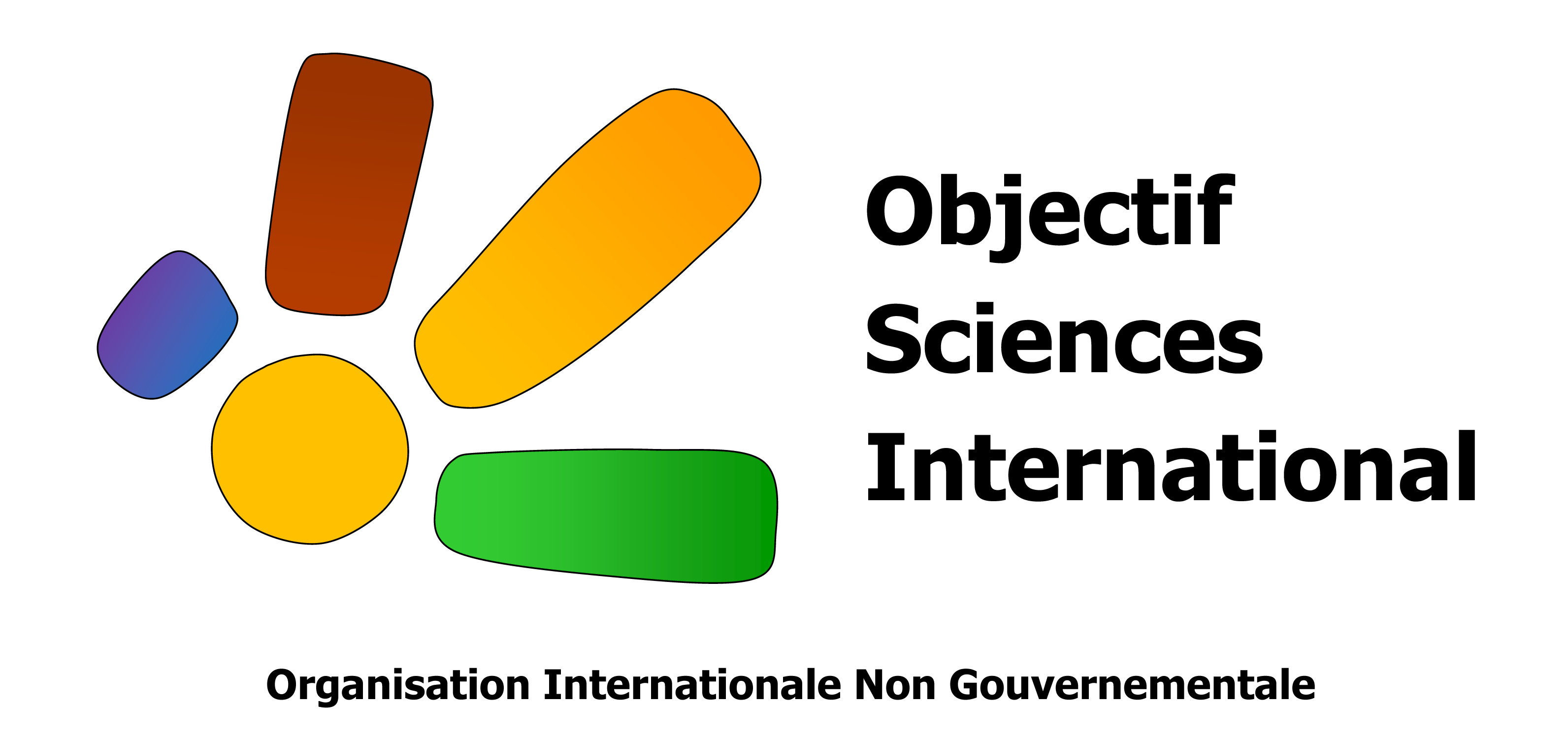Home > Actions et Journaux de Bord > Saisons passées > Expéditions OSI-Panthera Kirghizstan 2024 : Inscriptions ouvertes !
Introduction
In the heart of the heavenly mountains of Kyrgyzstan, interactive scientific expeditions are being carried out in partnership with the Naryn and Sarychat-Ertash natural reserves, as well with local organizations such as Ala too bugu and the Snow Leopard Foundation in Kyrgyzstan, to study the snow leopard and its ecosystem.
Setting camera traps, monitoring animals and gathering evidence of presence form the heart of our daily routine in wild, magnificent spaces.Fascinated by animals and not afraid of mountain living?
Then come and join us for an inclusive scientific group expedition, following the footsteps of snow leopards in Kyrgyzstan!
Here find our annual program :
Le Projet
During such times when a large portion of world biodiversity is threatened, protecting species in grave danger of extinction is vital. However, this is not possible without preliminary studies on these species so that we can learn more about their biology, behaviour, and habitat.
The more we know about them, the better we can protect them: this is the motto of many scientists. For this reason, we offer these useful holidays as part of the study of the iconic snow leopard.
You will experience a combination of the following:
- active participation in a study program on the snow leopard
- discovery of the exceptional animals, plants, and ecosystems of Tian Shan
- discovery of the country, people and culture of Kyrgyzstan
- an adventure into the heart of the celestial mountains of Asia
- physical mountain activity.
Here’s a short video clip of what an OSI-Panthera expedition entails. Thanks to Bruno Cedat, director of this video and participant of the August 2017 expedition to the Naryn reserve.
The fulfilment of expeditions, whether through Congés Science Solidaire (Group Science Holidays) for adults or Vacances Scientifques (Scientific Vacations) for young people, requires management by our scientific instructors, whose ratio will be 1 for every 6 participants. They will manage transfers (plane for supervisors, jeep and horse rentals), lodging (hotels, yurts and tents), food provision as well as other logistical, administrative (permits and taxes to enter natural reserves) and safety (medical assistance, MAM prevention and first aid, satellite telephones) requirements that are necessary for such trips.
This also requires some essential scientific, educational and logistical preparatory work, based on previous years’ expeditions, involving all members of the Objectif Sciences International NGO network.
Your participation contributes to the purchase of scientific material, such as camera traps, as well as to the analytical work and publishing of results. Part of these scientific, but also collaborative, missions is to help our local partners finance their operation: donation of scientific material, helping renovate base camps, university partner research, etc.
Your active participation on the ground, coupled with your financial contribution (which is kept to a minimum), is indispensable to this project, allowing us to raise awareness and protect the survival of an endangered species. Please take these factors into consideration when assessing the stipulated financial contribution.
Citizen science – definition:
Citizen science (sometimes called “civic science” or “crowd science”) is a means of producing scientific knowledge in which non-scientists – participate, actively and consciously, as individuals or in groups.
This year, a variety of dates and formats are proposed from mid-June to the end of October in Kyrgyzstan!

- Zones d’étude au Kirghizstan
Logos of the Sarychat-Ertash reserve, Naryn reserve and Snow Leopard Foundation in Kyrgyzstan
Expeditions of 19 days (June to September)
Sarychat-Ertash natural reserve:
3 sessions
Morning arrival and departure from Bishkek on the first and last day of the expedition.
The Sarychat-Ertash reserve is known for its very high density of wild ungulate animals (Siberian Ibex and Marco Polo sheep). The landscape is breathtaking; you will only find bushes at the bottom of the valleys, the rest of the time you will go through snowy alpine zones where vegetation is sparse.
Many large birds of prey (Golden eagle, bearded vulture, Himalayan vulture, eagle-owl) and predators (snow leopard, bear, wolf, lynx) live in this reserve.
Make sure you come armed with a good pair of binoculars and patience; flight distances,especially those of ungulates, are enormous!
Snowmelt in July and August causes a rise in the water levels of rivers and other glacial streams, making it difficult to cross the Ertash River (the main river of the natural reserve), even by horse. Therefore, throughout the season, we will stay either on the right bank (the northwestern part of the reserve) or the left bank (the southern part of the reserve).
We will change camp by horse every 2 or 3 days, which takes several hours.. We will return using the same route.
| Before you register, please read the description carefully : Sarychat.pdf Please Contactez-nous for more information! |
Naryn and Son-kul natural reserves:
3 sessions
Morning arrival and departure from Bishkek on the first and last day of the expedition.
The proximity of the natural reserve to Lake Song-Kul will allow you to observe numerous aquatic birds (anatids, waders, etc.) at the beginning of your stay. There will also be the opportunity to share daily life with semi-nomadic ranchers on the pastures of this magnificent, high-altitude lake.
The Naryn reserve is one of the last Kyrgyz sanctuaries of the Tian Shan wapiti. The landscape is extremely varied with the presence of spruce forests, glaciers and high-altitude plateaus. The reserve shelters large birds of prey (Golden eagle, bearded vulture, Himalayan vulture, eagle-owl, etc.), wild ungulates (Tian Shan wapiti, Siberian roe deer, Siberian ibex, and Marco Polo sheep) and their predators (snow leopard, bear, wolf, lynx).
However, please be aware that observation will be more difficult due to forest cover and low prey densities. Equip yourselves with a good pair of binoculars and patience!
Expeditions in the Naryn reserve will involve frequent travel. Generally, a day of horse travel will alternate with a day of exploration on foot to accomplish scientific work.
Over various summer expeditions, we will take turns exploring the central zone and the two other zones of the reserve.
| Before you register, please read the description carefully – Naryn.pdf Please Contactez-nous for more information! |
5-week expeditions
The Naryn natural reserve followed by the Sarychat-Ertash reserve. These two expeditions will take place in areas that are very similar geographically but with different vegetation and landscapes; the lower part of the Naryn reserve is wooded while Sarychat-Ertash boasts many tall, rocky and semi-arid mountains. The sights and ecosystems encountered couldn’t be any richer or more varied!
There will be three break days in Bishkek during the expedition, with lodging and food costs covered by the NGO (3 days maximum).
![]() Sunday 18 June to Thursday 27 July: Naryn reserve followed by the Sarychat-Ertash reserve
Sunday 18 June to Thursday 27 July: Naryn reserve followed by the Sarychat-Ertash reserve
![]() Sunday 16 July to Thursday 24 August: Naryn reserve followed by the Sarychat-Ertash reserve
Sunday 16 July to Thursday 24 August: Naryn reserve followed by the Sarychat-Ertash reserve
Expedition of 14 days - The protected zone of Shamshy followed by the Chong Jarguilchak Valley: 1 session
Morning arrival and departure in Bishkek on both the first and last day of the expedition.
These two valleys have very varied ecosystems, ranging from mountain zones to snow. The forest cover allows us to see numerous birds while the first snow might allow for some tracking! We aim to carry out the first animal inventories in these zones by recording any traces of presence.
In Shamshy Valley (protected by the Snow Leopard Foundation in Kyrgyzstan, a local association) we will be able to observe ibexes, which will be harder in the Chon Jarguilchak Valley where the densities are lower mainly due to poaching. As a result, our team team are eager to work there and engage with locals.
The presence of the leopard is confirmed in both valleys, but their density is still unknown. We will set up and monitor camera traps.Unlike the other missions, this one takes place in a relatively less isolated setting (a few hours’ walk from the first tarmac road).
In view of the snow conditions at this time of year, travel will be mainly on foot. Horses will be an integral part of the expedition and will carry equipment from one camp to another, but will only be ridden when tired, conditions permitting. Prospecting will be carried out on foot, which may suit people who are put off by the amount of riding involved in other missions.
Before you register, please read the description of the 14 day October expedition carefully: Shamshy_Chong_Jarguilchak.pdf
Please Contactez-nous for more information! Contact details are at the bottom of this page.Sunday 22 October to Saturday 4 November (14-day TRACKING Special)
Financial contribution
From a logistical point of view, your financial contribution covers all the expenses on site (food, accommodation, transport, scientific educator, gamekeeper, access permit, etc.), as well as expenses linked to the scientific project (scientific equipment, genetic analysis, image sorting, valorization of results, participation in conferences, etc.).
In addition, you will have to pay for your own plane ticket (between €400 and €800 return).
Your financial participation (“action-donation”) coupled with your active participation in the field is the indispensable source - and calculated as accurately as possible - that allows this project of study, awareness and protection of a species in danger of extinction to LIVE.
It is therefore necessary to take into account the different parameters mentioned above when assessing the amounts of the financial contributions requested.
Tax deduction:
As expeditions organised by our NGO, Objectif Sciences International, are considered public interest, 66% of the total registration and travel fee (plane ticket), , is tax-deductible for French citizens, in the same way as donations (regardless of who pays for your registration).
If whoever pays the donation is taxable, they will be reimbursed up to 66% of the fees the fiscal year after this commitment.
Additional donations to the program:
Once you register for an expedition, you can choose to make an additional donation to the program in line with your means.
As an example, if we are unable to organise an expedition for Kyrgyz youth (like we have done in previous years), we will use your donations to renovate a cabin in one of the reserves. By providing basic comfort for local guards, they will be more present in the reserves and, therefore, more able to protect these territories.
WARNING! Please remember!
A scientific expedition is not a tourist holiday! We will be travelling across remote areas so will be at the mercy of the locations we observe, behold and live. Will we get the chance to see the leopards? Will we have the misfortune of being hit by rain, hail or snow?
Uncertainty is certain and nature is whimsical. That’s the beauty of adventure! Everything is organised with safety at its core so that we can accomplish our mission to study and preserve this feline. We will adapt according to your pace, inclination and ability. However, you must be open to the experience, the adventure and other people!
This is a human adventure, where group living and daily tasks in an isolated area are not someone else’s job. We are a team
team
that must always stick together and help each other!
We are always trying to improve the program so we are always open to comments and suggestions. However, bear in mind that the purpose of this program is to fulfil the scientific project and we will not make changes of a touristic nature.
Our goal is science education through real research projects…not tourism! However, if you’re of the appropriate age, you can extend your stay in Kyrgyzstan and visit other parts of the country. Should you choose to do this, we recommend that you stay after the expedition as you will already know a bit about the Kyrgyz culture and have picked up a few words! Please note that you are solely responsible for the organisation of such extensions.

- Lequel ou lesquels aurez-vous la chance d’observer ?
Contact us without further delay – space is limited!
Structure name: OSI-PANTHERA Research and Education Program
Toll-free number (from a French landline): 09 72 30 55 95
International callers (outside France): +33 9 72 30 55 95
Email: direction osi-panthera.org
Phone contact location: France
Support us by using the interactive LILO search engine: https://www.lilo.org/fr/osi-panthera/
Follow us on Facebook: https://www.facebook.com/osipanthera
Follow us on Instagram: osipanthera
Subscribe to our YouTube channel: https://www.youtube.com/channel/UCk...
If you want to make the link between your volunteer experiences, internships, etc. use our page LinkedIn https://www.linkedin.com/company/os...
| This website is dedicated to the OSI-PANTHERA Research Program proposed by Objectif Sciences International, a non-governmental organization (NGO).. |
Vidéo
You can see most images and videos produced on our expeditions here: http://www.osi-panthera.org/Visionn...
Le Projet de Recherche
The goal of the OSI-Panthera program is to study the snow leopard population in Kyrgyzstan and Nepal, by means of a genetic study and camera traps.
A wildlife survey is also conducted. In addition, one of our priorities is to raise awareness about environmental protection among the local population.
Concept Appris sur le séjour
Identifying species by direct observation or through traces of presence along transects, collecting faeces and hair samples, setting up and monitoring camera traps.
Le Matériel Utilisé
GPS device, field notebook, binoculars, telescope, camera, camera traps.
Le lieu
In Kyrgyzstan you will be in the Naryn and Sarychat-Ertash reserves or else in the Shamshy and Chon Jarguilchak Valleys.
Le Quotidien sur Place
In the mountains our daily routine will involve travel from one camp to another by horse every 2-3 days. Once set up at camp, we will survey the transect in the hills or valleys (by foot) looking for signs of snow leopard presence but also to placing and setting camera traps.
There will be daily wildlife observations, particularly at dawn and dusk via lookout points.
The intensity of the transects could vary slightly depending on you, your energy levels, motivation and the weather. A good dose of flexibility will be necessary!
Daily life on site also involves participating in everyday group tasks (washing dishes, setting up and tidying camp, preparing saddlebags and horses, helping prepare meals, etc.).
L'Équipe
Here is the OSI-Panthera leadership team in Kyrgyzstan (past and present): http://www.osi-panthera.org/L-Equip...
The team will consist of a maximum of 8 participants, 1-2 science educator(s) (Kyrgyz or French) and 2-3 rangers or villagers.
Parrains
Please find the OSI-Panthera program sponsors here: http://www.osi-panthera.org/Parrain...
L'Hébergement
Lodging will be in guest houses in towns and villages. Once in the mountains, a tent will be your shelter from inclement weather. Sometimes we will have to bivouac (camp without cover), depending on the weather and motivation of the group.
Témoignages
Le Programme au Jour le Jour
In each zone’s description, you will find an example of the proposed expedition course. However, please be aware that unexpected events and program changes will also be part of the program!
Please refer to this link:
http://www.osi-panthera.org/Documen...
Journaux de Bord
You can access log books for completed and ongoing expeditions.
Documents produits
Available documents are as follows:
End of season statements,
Seasonal scientific reports and Intern reports written by our participants
Dans la presse
Here are various media articles about our adventures: http://www.osi-panthera.org/La-pres...
Affiches & Flyers

- Nouvelle affiche du programme OSI-Panthera !
You can access our promotional documents here: http://www.osi-panthera.org/Documen...
A prendre avec soi
Given that this will be a unique and likely new experience, we would like to help you prepare. We have produced several documents to help and guide you as much as possible while preparing for your expedition.
You can find them
to help you.





















